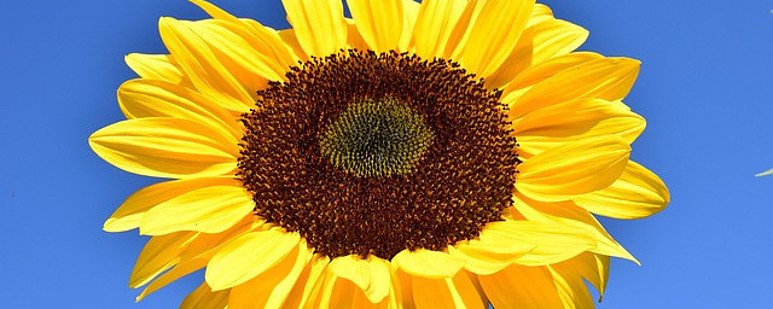
Sunflowers (Helianthys Annuus) are a great flower to start with if you want to start a flower farm. With many varieties to choose from they Sunflowers come in the traditional yellow, to gold, orange, bronze and burgundy. They are easy to grow in most any soil. They just need some sun, moderate amounts of water and to be protected from strong winds. A lot of growers choose single stem sunflowers for cutting because they are easily recognized and people generally love them. They bloom in as little as 55 days and, as such, you could easily have new blooms being reduced throughout the sinner and into the early fall – just in time for Thanksgiving. Most flower around 80 – 95 days. There’s a lot to learn about the best way to grow Sunflowers.
What is a Sunflower?
Sunflowers are heliotropic. That means they turn the face of the flower to follow the movement of the sun across the sky from east to west. The flower faces return to face the east during the night and does it again the next day. The flower will do this until the flower head becomes too heavy with seeds.
It is believed that Sunflowers originated in the Americas cultivated by the native people as early as 3000 BC who used the seeds for flour. Some say that Sunflowers were cultivated before corn. Spanish explorers took the native Sunflower to Europe sometime around 1500 as an ornamental plant. History says that it was Peter the Great who brought it to Russia where the Sunflower was both ornamental and cultivated for oil by 1769. By 1830 there was a patent and Russian farmers began to grow it commercially.
Sunflowers are recognized worldwide as a beautiful ornamental plant and as an important source of food. Worldwide it is a very important agricultural crop worth billions of dollars.

How to sow Sunflowers
Traditional Sunflowers can grow up to 16 feet tall. They are the giant varieties and, although there are some of those that can be used for cut flowers they are generally not the ones you want for cutting. Dwarf varieties grow 1 to 4 feet tall. Sunflowers are usually annuals but there are perennial varieties that grow well in Hardiness Zones 4 8 depending on cultivar.
Sunflowers want full sun, at least 6 hours. They can grow in most any soil, not usually needing fertilizing unless the soil is very poor. You can get a soil sample to your local agricultural centre and they will tell you the quality of your soil and what you may need to amend it.

If you choose a giant viariety then you will need to plant each plant 2 – 3 feet apart. Because they grow so tall and have heavy flower heads you may have to stake them. Smaller varieties can be sown 6 inches apart. Starting them indoors and waiting until the soil is warm and the risk of frost is past is a good way to get a head start on the season. Some gardeners say that the larger single stalk Sunflowers should be planted closer together than 2 feet and by doing this they will not develop the very thick stalks that make them undesireable to have as an ornamental flower. The low growing varieties that branch out, some say, should be given more room, 12-18 inches apart and pruned aggressively for healthy blooms and longer stalks.

Once you have established your Sunflower crop you will find that they are drought tolerant. They do, of course, need deep watering before, during and after blooms appear. Do not let water pool around the base of the plant. Deep watering allows the roots of the plant to grow down and this supports a larger, taller plant.
When do sunflowers bloom?
Annual sunflowers bloom during summer and into autumn. Sow new plants every few weeks and you’ll enjoy non-stop flowers until the first frost. Perennial sunflowers bloom for a period of 8-12 weeks with some beginning as early as July and others finishing as late as October. If you plan your season right you can have plants and flowers in various stages of growth and bloom throughout the growing season. That way you have a continuing source of revenue.
Varieties of Sunflowers
Giant Sunflowers
Height: 9 to 16 feet tall
Bloom size: 10 to 14+ inches across
Giant or Mammoth – these have flowers that can measure a foot or more across. Good for fence lines and backgrounds they are the sunflowers that produce edible seeds. They are susceptible to falling over due to their height and the weight of the flower head and will need staking.
Dwarf Sunflowers
Height: 1 to 4 feet tall
Bloom size: 2 to 10 inches across.
Good for containers and house gardens, dwarf sunflowers can be double, bicoloured and many have multiple blooms for each plant. These sunflowers are perfect for cutting and arrangements.
Double Sunflowers
Height: 2 to 6 feet tall
Bloom size: 4 to 8 inches across
An attractive variety, double sunflowers are noted for their texture and will bring in a crowd. Semi-double and double, the flowers last longer and are wonderful for cut flowers.
Specialty Sunflowers
Zones: 4-9
Height: 1 to 10 feet tall
Bloom size: 2 to 5 inches across
Generally perennial specialty sunflowers were cultivated for their toughness and the fact that they bloom over and over. These varieties have multiple, smaller flowers per stalk. A great choice for display.

Conclusion
Sunflowers have been hybridized, grown in Europe and the Americas for oil, seeds and as an ornamental flower. Versatile and beautiful they are an awesome backbone to a cut flower garden. Seeds are available through a wide range of suppliers so you will be spoiled for choice. Plan a little and your Sunflower garden will produce a wide ranging and profitable crop.




I love sunflowers! Sunflowers and Morning Glories together are my favorite! So beautiful with the blue and gold together like that. I’ve seen sunflowers for sale, of course, but never actually considering flower farming. How large an area of sunflowers would a person need to have enough to make it worth going into business with them? I’m thinking of doing it along with other farmers market stuff…
Thanks in advance,
Anna
This site provides comprehensive information on the best way to grow sunflowers, including soil preparation, planting techniques, and care and maintenance. The step-by-step guide is easy to follow, and the website also includes tips on how to deal with common sunflower pests and diseases. One question that comes to mind is whether this guide covers different types of sunflowers or focuses on a particular variety. Another question is whether the website provides information on how to harvest and store sunflowers. Overall, I think this website is a valuable resource for anyone looking to grow sunflowers and can help beginners achieve success in their first attempts at sunflower farming.
Hi, Deede, thank you for this in-depth guide into sunflower growing. I have always known sunflowers as the source of sunflower oil and never as a cut-flower. Your have opened my eyes to yet another use of sunflower. From what you have described, I think the variety which is grown more here falls in the middle between the giant and the dwarf varieties. If I am allowed to ask; which of the types has much oil? I would love to concentrate on that. Once again thank you very much for this information.
Thanks. It is the large black sunflower seeds that are used for oil. They are grown as a commercial crop in many parts of North America.